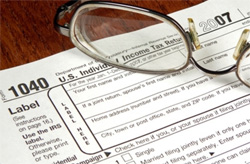When checking a tax issue or other government regulation, you often see the term “Safe Harbor”.
For example, the IRS requires that tax payers file estimated taxes on a quarterly basis, if there is going to be income tax liability not covered by employee withholding.
 What choice does a taxpayer have if she expects that taxable income in 2016 is greater than 2015, and that 2016 taxes will also be greater than the tax liability for 2015?
What choice does a taxpayer have if she expects that taxable income in 2016 is greater than 2015, and that 2016 taxes will also be greater than the tax liability for 2015?
If you pay enough estimated taxes in 2016 to bring your total tax payments greater than 110% of your total tax liability for 2015, you can be considered to be in “safe harbor”, that is you will not have penalties
for underpayment of your 2016 tax liability even though you will owe additional taxes when you file your 2016 tax return.
Example #1
Frank and Katie Brown are a married couple who filed jointly on their 2015 tax return. Their adjusted gross income (AGI) for 2015 was $90,000, and their total tax liability for 2015 was $18,000. In 2016, Mr. and Mrs. Brown need to pay the smaller of $18,000 or 90% of their expected tax for 2016 to avoid any underpayment penalty.
If Frank and Katie’s AGI is over $150,000, they need to pay $19,800 (110% of $18,000) or 90% of their expected tax for 2016 in order to stay in safe harbor.
The dictionary says that “A safe harbor is a provision of a statute or a regulation that specifies that certain conduct will be deemed not to violate a given rule. It is usually found in connection with a vaguer, overall standard.”
Potential “Safe Harbor” rules that affect residential lending institutions.
The “Consumer Financial Protection Bureau”, (CFPB), a new federal agency was created by the Dodd Frank Act, and issues regulations designed to prohibit abusive lending practices.
One of the rules defined by the CFPB is a “Qualified Mortgage”, which includes:
- No Excessive Upfront Points and Fees – not in excess of 3% of the amount borrowed.
- No Toxic Loan Features
- No interest-only loans
- No negative-amortization loans. These are loans where the principal amount borrowed increases over time, even as monthly payments are being made.
- No terms beyond 30 years.
- No Balloon Loans. unless the lender is considered a “small creditor”
- Limits on Debt-to-income Ratios no higher than 43%. The debt to income ratio compares the amount of money a person earns each month to the amount he or she spends on recurring debt obligations.
CFPB maintains a web site where prospective borrowers can read a section “Shopping for a Mortgage? What you can expect under federal rules” This is an 18 page section which emphasizes the benefits of a Qualified Mortgage..
However, on the CFPB web site labeled “Basic Guide for lenders, What is a Qualified Mortgage?” Â there is the following:
“Extra Note: Even if a loan is not a qualified mortgage, it can still be an appropriate loan. You can originate any mortgage (whether or not it is a QM) as long as you make a reasonable, good-faith determination that the consumer is able to repay the loan based on common underwriting factors. You can continue to rely on your sound, tested underwriting guidelines that you have used in the past to make loans that have generally performed well, as long as you document the information you consider.”
Small Creditor Qualification
If the lending organization has assets below $2 billion at the end of the last calendar year and originated 500 or fewer first year first-lien closed-end residential mortgages, then the lender may be treated as a Small Creditor. In 2016 the number of mortgages has been raised from 500 to 2000, and excludes the loans that the creditor or its affiliate keep in their portfolio..
However after January 16, 2016 there is an additional question: Were over 50% of your organization’s first lien covered transactions in the prior year secured by properties in rural or undeserved areas?
Is everyone confused?
As with many tax and other government benefits and regulations, it takes expert interpretation to determine whether safe harbor rules exist, how they are defined, and have they recently changed.
 For most people, using IRA dollars for charity is a two-step process. You take money from your IRA, reporting taxable income. Then, you donate it to the charity or charities of your choice, perhaps claiming a tax deduction for the contribution.
For most people, using IRA dollars for charity is a two-step process. You take money from your IRA, reporting taxable income. Then, you donate it to the charity or charities of your choice, perhaps claiming a tax deduction for the contribution. Approximately 55 million people receive social security benefits and of those 15 million people pay taxes on their social security benefits. Demographically 40 million of the beneficiaries are age 65 or older.
Approximately 55 million people receive social security benefits and of those 15 million people pay taxes on their social security benefits. Demographically 40 million of the beneficiaries are age 65 or older.
 Dependents are a great way to lower your tax liability. The IRS gives an allowance for reduced tax payments for tax payers that provide monetary support to others (dependents).
Dependents are a great way to lower your tax liability. The IRS gives an allowance for reduced tax payments for tax payers that provide monetary support to others (dependents).

 However the IRS web site says the following:
However the IRS web site says the following: What choice does a taxpayer have if she expects that taxable income in 2016 is greater than 2015, and that 2016 taxes will also be greater than the tax liability for 2015?
What choice does a taxpayer have if she expects that taxable income in 2016 is greater than 2015, and that 2016 taxes will also be greater than the tax liability for 2015?